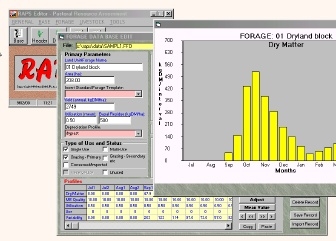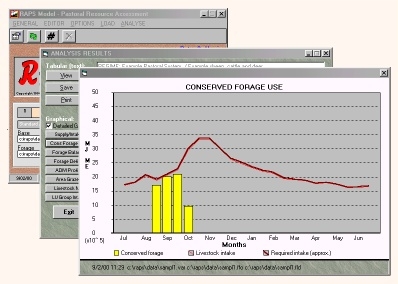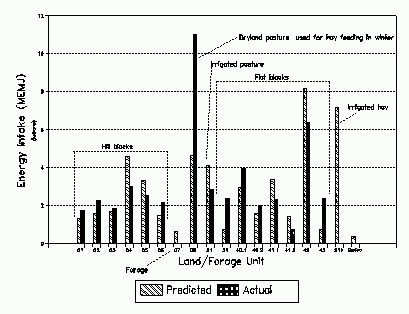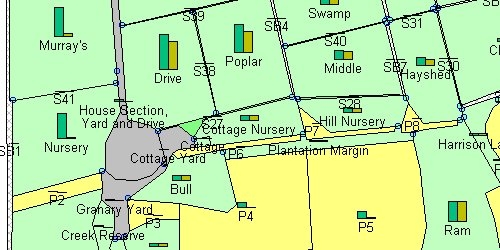RAPS is a unique and sophisticated resource assessment package, with a wide range of analysis and output options. It is a free-standing menu driven programme with in-built database management and mouse-driven graphical manipulation of data profiles.
RAPS forage database edit screen.

A range of user levels. At its simplest level of operation a pastoral system may be setup using default options and the selection of pre-formed “standard” files, representing land/forage types and livestock classes. At the other extreme, RAPS allows a high degree of customisation of nearly all input variables, permitting the representation of complex and unique pastoral systems. View the scope of input parameters.
RAPS main screen overlayed with results screens.

Pastoral systems composed of more than 1,000 individual forage/land units may be analysed. This allows individual properties through to districts or regions to be analysed. All analyses are carried out at a resolution of 48 periods per year (approximately quarter monthly).
Complex management policies and constraints can be applied. These include the ability to control the pattern of forage use, the level and form of utilisation, and priority or exclusive assignment of particular livestock classes to land units (eg paddocks, blocks or land classes).
Land/forage units are partitioned or stratified according to herbage quantity and quality. Unless management constraints or other use patterns are imposed, the allocation of livestock to specific land/forage units is prioritised on the basis of livestock forage quality requirements and the sequential minimisation of forage quality “loss”.
Predicted versus actual stocking loads within each land unit can be graphically compared.
Comparison of predicted and actual livestock intake within each land unit.

A seasonal profile of available (standing) dry matter is generated for all grazed areas, or for specified land/forage unit groups. This is used to check original pasture estimates or to identify deviations from the normal or planned forage supply.
Numbers of livestock within classes in a single database may be static or dynamic. Numbers of certain livestock classes can be held static while the numbers of livestock in other classes are adjusted to utilise forage not consumed by the “static” livestock.
Statistical data of variability of herbage production can be used to generate livestock support capacities for a random sequence of any number of years. In this way, inter- year variability of forage supply can be taken into account to estimate long term livestock carrying capacity.
Forage resource relationships and complementaritybetween land units (eg blocks or paddocks) of a pastoral system can be analysed. This involves the assessment of the importance or contribution of a land unit as part of the whole system and, conversely, the impact of the removal of that land unit from the system. The results can be used in the analysis of economic value and opportunity costs.
Land, forage and livestock data from a range of sources can be incorporated, including from other specialist modelling and analysis systems. Examples are geographical information and land evaluation systems (GIS), pasture/grassland production models (eg based on primary environmental parameters), applied research and resource monitoring systems.
Input/output linkages with GIS systems (eg Map Maker Pro© or ArcInfo©). The linkages permit the semi-automatic generation of forage databases and the spatial display of RAPS output.
Yield and intake within each land unit (RAPS output linked to GIS map).

Results are summarised on-screen in both text and graphical form. Detailed results can be printed or saved as files which can be incorporated into reports using word processors. Output files are in standard formats (text, csv or spreadsheet) to facilitate further analyses and graphical representation (eg for gross margins and other economic analyses).
A batch file, incorporating a number of task orientated commands, may be used to automatically perform analyses. This is particularly useful for complex or repetitive analyses of a single or multiple pastoral systems.
A series of indicators are used to check that a pastoral system is realistically represented.
RAPS is currently available in English (an earlier version is translated to Chinese). Procedures that will enable translation into other languages have been tested.
